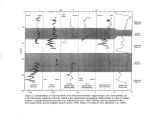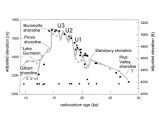| OCR Text |
Show Darrell S. Kaufman, Dept. of Geology, Utah State Univ., Logan, UT 84322- 4505 AN OVERVIEW OF NEW AMINO ACID RACEMIZATION STUDIES IN THE BONNEVILLE BASIN- QUATERNARY GEOCHRONOLOGIC, PALEOTHERMOMETRIC, AND PALEOHYDROGEOGRAPHIC RESULTS Over the past four years, the Amino Acid Geochronology Laboratory at Utah State University has been engaged in studies aimed at resolving several outstanding scientific questions pertaining to the Quaternary geologic history of the Bonneville basin. Specifically, these studies have attempted to: ( 1) evaluate the late Pleistocene temperature lowering; ( 2) determine when the Bear River was diverted into the basin; and ( 3) reconstruct the history of pre- Bonneville lake- level changes. Here, I present an overview of ongoing research and highlight a few recent results. Common to this research is the analysis of biomolecules preserved within the carbonate matrices of Pleistocene mollusc and ostracode shells. The extent to which diagenetic chemical reactions have progressed in fossil proteins is proportional to the length of time elapsed since the organism lived and to the average, long- term ambient temperature. For geochronological purposes, a local calibration curve is developed using independently dated shells to evaluate the reaction rates. For paleothermometric purposes, the age equation is solved for temperature using independently dated shells to derive an average postdepositional temperatures. For either purpose, the most reliable of the complex network of diagenetic reactions is amino acid racemization, which involves the inversion of L- amino acids to their D- isomeric configurations. When organisms are living, they utilize amino acids exclusively of the L- configuration. Upon death and removal of biologic constraints, L- amino acids begin to racemize to their D- configuration. The abundance of D- relative to L- forms ( DL ratio) of a specific amino acid defines the extent of racemization for that amino acid. The ratio increases with time and temperature until the rate of formation of D- amino acids is compensated by the reverse reaction, and the reaction reaches equilibrium. Beginning in 1995, Adam Light ( MA Geography, University of Colorado) and I, have collected fossil snails ( mainly Lymnaea ( Stagnicola) and Amnicola ( Pyrgulopsis)) from dozens of sites across the Bonneville basin where the ages were previously determined by radiocarbon, or could be inferred by stratigraphic position. We also obtained 25 AMS 14C dates on new shell collections. Finally, we heated modern Lymnaea and Amnicola shells under laboratory controlled conditions to derive a kinetic equation that defines the temperature sensitivity of the racemization reaction ( specifically, isoleucine epimerization). Analyses of three radiocarbon- dated late Holocene Lymnaea collections provide data on the long- term reaction rates at ambient temperature to further constrain the kinetic equation. Based on these analyses, we estimated an average ( effective diagenetic) temperature of about 1 ± 2° C in the Bonneville basin for the interval of ca. 25- 13 ka, or about 10° lower than present mean annual temperature. The amino acid data support evidence from glacial and periglacial features in the northern Great Basin indicating a pronounced temperature lowering during the late Pleistocene. Beginning in 1994, Amy Hochberg, David Bouchard ( both MS Geology, Utah State University) and I have studied the Quaternary history of Lake Thatcher, located in the northeasternmost corner of the Bonneville basin, where the Bear River met the shore of Lake Bonneville. Quaternary deposits in the Thatcher basin hold the key to understanding when lava flows along the north rim of the basin diverted the Bear River from its previous course down the Snake River and into the Pacific, to its present route into the Bonneville basin. Because the Bear River is the single largest river in the Great Basin, the timing of this event is pivotal to interpreting the climate significance of lake- level changes, and the biogeography of aquatic organisms, in the Bonneville basin. Amino acid data were used to evaluate the chronostratigraphy of lacustrine units deposited in Lake Thatcher, a small lake that formed prior to the incisement of Oneida Narrows ( the gorge that now connects the Thatcher and Bonneville basins). Several middle and late Pleistocene tephra beds, especially a newly discovered tephra erupted from Mt. St. Helens ca. 100 ka, combined with radiocarbon dates, constrain the ages of Lake Thatcher deposits and provide a means of calibrating the rate of isoleucine epimerization in this region. The calibrated amino acid age of the youngest |

































































































































































